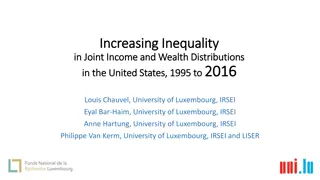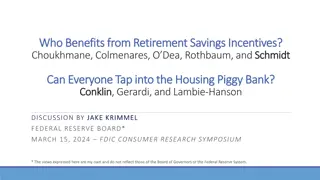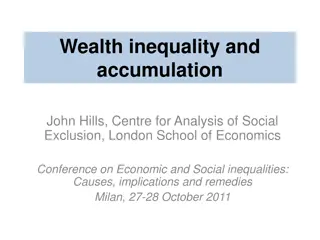Understanding Economic Growth and Global Wealth Trends
Explore the significance of economic growth, wealth of nations, and human welfare indicators across rich and poor nations. Learn about the role of resources, technology, and institutions in fostering economic growth. Delve into historical perspectives and the evolution of global GDP per capita over time.
Download Presentation

Please find below an Image/Link to download the presentation.
The content on the website is provided AS IS for your information and personal use only. It may not be sold, licensed, or shared on other websites without obtaining consent from the author. Download presentation by click this link. If you encounter any issues during the download, it is possible that the publisher has removed the file from their server.
E N D
Presentation Transcript
11 Economic Growth and the Wealth of Nations
Previously ____________ is when savers and lenders utilize banks in the market for loans. ____________ is when borrowers go directly to lenders (for example, offers of stocks and bonds) Bonds are loan contracts that are typically traded in secondary markets. Stocks are ownership shares in firms. U.S. Treasury securities are the bonds used by the federal government to finance debt.
Big Questions 1. Why does economic growth matter? 2. How do resources and technology contribute to economic growth? 3. What institutions foster economic growth?
Wealth Matters GDP Basic measure of a nation s income Value of all final goods and services produced in a country GDP per capita is a basic measure of average living standards Economic growth
Human Welfare in Nations, Poor vs. Rich Life indicators Poor Rich G D P per capita, P P P in 2011 international dollars 1872 dollars 40651 dollars Infant mortality rate per 1000 live births 53 4 Under 5 mortality rate per 1000 76 5 Life expectancy at birth in years 62 81 Physicians per 10000 people 2.1 29.3 Access to improved water in percent 68.7% 99.6% Access to improved sanitation in percent 37.1% 99.9% Access to electricity in percent 31.2% 99.7% Mobile cellular subscriptions per 100 people 55 113 Secure internet servers per million people 1.43 1181.93 Literacy rate, adult male in percent 68% 99% Literacy rate, adult female in percent 53% 99% Female to male secondary enrollment ratio 0.89 0.99 Female to male postsecondary enrollment ratio 0.65 1.24
Historical Growth Economic historian Angus Maddison estimated __________ for many nations back to the year AD 1. Notes: For most of human history, the average person s life was one of _________________ There were global variations noticeable around 1700, but everyone was still very poor Industrial Revolution: rapid technological progress outpaced population growth
World Per Capita GDP: The Hockey Stick
Practice What You Know1 When economists use the phrase economic growth, what are they referring to? A. percentage changes in real GDP per capita B. nominal GDP growth C. real GDP growth D. average GDP across nations
Practice What You Know2 The period in time in which per capita GDP for the world started to increase faster than it had in the rest of history began during what years? A. 800s B. 1490s C. 1800s D. 1950s
Some Got Rich, Others Stayed Poor On average, we are all _________ than earlier centuries However, wealth is ___________________ United States, year 1800 Average income is $2,000 (in 2010 dollars) Liberia, year 2012 Average income is $1,200 (in 2010 dollars)
Per Capita Real GDP over 200 Years
Mathematics of Growth1 Wealth of the United States didn t happen overnight. _________ grew each year a little bit. Break out of poverty began in the 19th century Years Growth Rate 0 to1800 0.02% 1800 to 1900 0.64% 1900 to 1950 1.04% 1950 to 2000 2.12%
Mathematics of Growth2 Growth rate of real GDP per capita The most important growth rate we consider Economic growth
Computing Economic Growth Example United States G D P in 2013 in millions United States G D P in 2014 in millions Nominal G D P growth Price growth, or inflation Nominal G D P growth minus price growth equals real G D P growth Population growth Real G D P growth minus population growth equals real per capita G D P growth 16,768,100 dollars 17,418,900 dollars 3.9% 1.5% 2.4% 0.7% 1.7% equals economic growth
Growth and Income Levels over Time How long will it take income to double? Income doubling is significant and will not happen in a single year Suppose annual growth is 2%. How long will it take for the economy to grow by 100%? Compounding growth actually makes it occur faster than 50 years. It takes about 35 years. Rule of 70 If the _______________ is ?%, the size of that variable ________ every 70 ?years.
Exponential Growth Years Income 2% increase in income Income in next year Year 1 50,000 dollars 1,000 dollars 51,000 dollars Year 2 51,000 dollars 1,020 dollars 52,020 dollars Year 3 52,020 dollars 1,040.40 dollars 53,060.40 dollars Year 4 53,060.40 dollars 1,061.21 dollars 54,121.61 dollars Year 5 54,121.61 dollars 1,082.43 dollars 55,204.04 dollars Year 35 100,000 dollars Empty cell Empty cell
Rule of 70, Illustrated for $1 Annual growth rate Years to double Value after 70 years, approximately 0% 1% 2% 3% 4% Never 70 35 23.3 17.5 1 dollar 2 dollars 4 dollars 8 dollars 16 dollars
Practice What You Know3 If the annual growth rate of an economy is 7%, how long will it take for income to double? A. 5 years B. 6 years C. 8 years D. 10 years
Living Standards: 1950 to 2010 Average annual growth rate Negative 1.3% Country Real per capita G D P in 1950 863 dollars Graphical trend Real per capita G D P in 2010 394 dollars Democratic Republic of Congo Slow decrease in the beginning, faster decrease towards the end Continuous decrease after a fluctuation towards the beginning Increase in the beginning, a drop, and slight decrease Continuous increase then a drop towards the end Increase in the beginning, stability in the middle, a drop, and stability at the end Negative 0.7% Haiti 1,591 dollars 1,038 dollars Positive 0.1% Nicaragua 2,446 dollars 2,534 dollars Positive 0.1% Zimbabwe 1,061 dollars 1,135 dollars Positive 0.5% North Korea 1,293 dollars 1,698 dollars
Economic Growth Rates Since 1950 1 Average annual growth rate 1.1% Country Real per capita G D P in 1950 642 dollars Graphical trend Real per capita G D P in 2010 1,217 dollars Tanzania Continuous increase; rapid increase toward the end Continuous increase, slight drop, and increase again Continuous increase, large drop, and increase again Continuous increase 1.1% Lebanon 3,677 dollars 6,741 dollars 1.1% Rwanda 828 dollars 1,544 dollars 1.2% El Salvador Nigeria 2,254 dollars 4,452 dollars 1.5% 1,140 dollars Increase, small bump, and continuous increase again 2,840 dollars
Economic Growth Rates Since 1950 2 Average annual growth rate 2.0% Country Real per capita G D P in 1950 14,476 dollars Graphical trend Real per capita G D P in 2010 46,164 dollars United States Near linear growth Near linear growth Near linear growth Near linear growth Constant growth; faster increase toward the end 2.0% Mexico 3,581 dollars 11,682 dollars 2.1% Australia 11,221 dollars 38,735 dollars 2.1% United Kingdom 10,506 dollars 35,999 dollars 2.2% Chile 5,556 dollars 21,019 dollars
Economic Growth Rates Since 1950 3 Average annual growth rate 2.7% Country Real per capita G D P in 1950 Graphical trend Real per capita G D P in 2010 Turkey 2454 dollars Constant growth; faster increase toward the end Near linear growth Near linear growth Near linear growth Near steady in the beginning and middle, rapid growth towards the end Near linear growth 12452 dollars 2.9% 4.1% 4.4% 4.9% India Japan Singapore China 937 dollars 2,908 dollars 3,360 dollars 687 dollars 5,105 dollars 33,209 dollars 43,963 dollars 12,160 dollars 5.5% South Korea 1,293 dollars 32,855 dollars
Twenty Years of Growth in Shanghai
Economic Growth Rates Since 1960 1 General characteristics Life expectancy Physicians per 10000 people Years of school completed Portion of income spent on food Average workweek Workforce in agriculture or manufacturing Home ownership 1960 69.7 years 14.8 2010 78.3 years 27 10.5; median 27% 12; average 8% 40.9 hours 37% 34 hours 19% 61.9% 67.4%
Economic Growth Rates Since 1960 2 New home One-story house Two-story house Size 1,200 square feet 2 2,457 square feet 3 Bedrooms Bathrooms 1 2.5 Central air conditioning? No Yes
Economic Growth Rates Since 1960 3 Best-selling car Model Price in 2010 dollars 19,753 dollars Miles per gallon Horsepower Air conditioning? Automatic transmission? Airbags? Power locks and windows? Chevrolet Impala Chevrolet Impala Toyota Camry Toyota Camry 26,640 dollars 20 to 29 268 Standard Standard 13 to 16 135 Optional Optional No No Standard Standard
Economic Growth Rates Since 1960 4 T V An antique television 23 inches Black and white A modern television 50 inches High-definition color 500 dollars Size Display Price in 2010 dollars 1,391 dollars
The Causes of Economic Growth Economic growth affects income, life expectancy, and standards of living. The sources of economic growth are:
Resources1 Resources are the inputs used to produce goods and services. Land Coal in United States Oil in Saudi Arabia Lumber in Canada Geography affects weather, disease, and trade possibilities Land is not enough for growth
Resources2 Labor Effective labor Labor adjusted for training and education Training includes everything from literacy to specific job training A more educated workforce is generally more productive
Resources3 Capital Factories, computers, roads Example: the standardized shipping container revolutionized world trade The most developed countries have impressive roads, bridges, tools, and computer networks
Capital and Growth Early contributions to growth theory focused on the role of ______________. We thought we could just build a bunch of _____ _____________ to help countries grow. However, factories, dams, and other large capital projects fell into disrepair. They did not mesh well with rest of economy. There must be other factors of economic growth as well.
Technology1 Technology Technological advance Introduction of new knowledge or production techniques Produce more for less Classic example: Henry Ford s assembly line Agricultural advances allow us to grow more food per acre
Technology2 Economic growth occurs when the _________ and _________ work together. Still a question, though: Why do some areas innovate (and grow) more than others? Why did the United States grow and innovate while Africa didn t?
Institutions1 1950 Liberia wealthier than Taiwan Today GDP per capita in Taiwan is more than 20 times greater than Liberia Why? Political stability in Taiwan, along with well- defined property rights protection Coercion, corruption, and instability in Liberia; nondependable system of ownership Where do you want to invest?
Institutions2 Institutions Significant practice, relationship, or organization Conditions in which decisions are made Include _______, _________, and _________ Also include work habits, expectations, and political behavior
Institutions3 Important institutions for economic growth 1. Political stability and rule of law 2. 3. Stable money and prices 4. Competitive markets 5. Efficient taxes 6. 7. Flow of funds across borders
Political Stability and Rule of Law Liberia, 1980 2003 Staged elections, rebel takeovers, violent upheavals, violence against citizens About $4 billion in international aid given, meant for industry and medical infrastructure (think of this as a blind application of Solow) Most aid was seized by force by whoever thought they needed it Blanket aid does not by itself provide incentives for education and investment Nothing was done to eliminate instability to create an environment for economic growth!
Private Property Rights Individuals can own _______ and _______, and the resulting output created by those resources. Perhaps the single greatest incentive for voluntary production Workers and producers can own a share of what they produce, so there is an incentive to produce more and grow Great example: Xiaogang, China, 1978 Farmers split commune into family-owned plots and agreed to keep surplus agricultural output beyond government quota
Result of the Agreement Agreement: No longer take money or food from government Result Agricultural boon in Xiaogang More output than previous five years combined Chinese leaders instituted agricultural reforms in 1980s and manufacturing reforms in 1990s Lesson? China grew not because of new resources or technology, but because of the institution of private property rights
Stable Money and Prices Makes people reluctant to invest Decreases future growth possibilities In the United States The Fed is charged with administering ____________ _________ The Fed is designed to be largely politically independent Governor terms at the Fed are staggered so that no president can appoint more than two governors
Competitive Markets Characteristics of competitive markets It is easy for firms to enter and exit with __________ _______________. Buyers can expect to find low prices and wide availability of goods. Benefits to society Creative destruction occurs and new technologies replace outdated methods. This fuels economic growth. Only the fittest firms survive, so inefficiency is eliminated over time. __________ is encouraged.
Efficient Taxes Taxes represent a trade-off They must be high enough to support effective government. Taxes change __________ by doing less of the activity that is taxed. Often, ______ and ______ are taxed. Import tariffs also impede growth. Challenge: Find a tax level that will support the government without crippling economic growth.
International Trade Specialization and trade Creates ______ and allows countries to consume goods they cannot produce on their own. Output (GDP) increases when countries produce goods in which they have the comparative advantage (lowest opportunity cost). Without trade? Many countries would not be able to produce many resources necessary for production, and growth would stop.
Flow of Funds across Borders Investment requires ________ Opportunities for investment expand if you have access to savings from around the globe If foreigners can funnel their savings into your economy, your firms can use these funds to expand Restrictions on the flow of capital across borders Hurt domestic firms as they are relegated to seeking funds from solely domestic savers
Practice What You Know4 Land, labor, and capital are considered A. resources. B. technology. C. institutions. D. investments.























